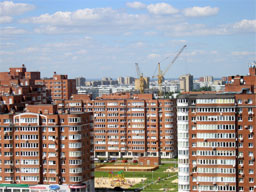A monotown (from Russian monograd) is a town whose economy is dominated by a single industry or company. The term is especially often used in Russia, where the Soviet planned economy created several monotowns in supposedly rational locations, often in geographically inhospitable areas. The situation in many of Russia’s monotowns is highly problematic due to their inflexibility and uncompetitiveness.
History
The Soviet plan economy aimed to establish industrial facilities in rational locations, based on military, political, bureaucratic and economic criteria. The goal was to maximise regional specialisation. The dominant enterprise was responsible not only for production, but for providing social services to the population.
After the dissolution of the Soviet Union, most of the monotowns’ dominant enterprises were privatised, but by the end of the 1990s, many had gone bankrupt due to uncompetitiveness. The government tried to delegate the responsibility of providing social services from the companies to the local municipalities, but these lacked resources to complete the transformation.
Monotowns today
According to a Russian government study conducted in 1999-2000, there were 467 cities and 332 smaller towns in Russia which could be classified as monotowns. The combined population of these towns was 25 million, or a sixth of the country’s total population. The 900 monotown enterprises – most of them involved in heavy industries such as manufacturing, fuels, timber, pulp and metallurgy – accounted for more than 30% of industrial production.
Problems
Due to their nature, many monotowns have narrow and inflexible economies, and an immobile work force. Many of their businesses are uncompetitive, producing wrong products in the wrong places. Monotown residents are hesitant to move away and seek work elsewhere, because they would lose the workplace-dependent social benefits. The monotowns suffered greatly in the late-2000s recession, leading to mass unemployment in the cities.
In one high-profile incident, some 300 residents of the north-western town of Pikalevo blocked a major highway to protest against financial difficulties resulting from unpaid wages. Prime Minister Vladimir Putin travelled to the city and ordered the owner of the city’s dominant company BasEl Cement Pikalyovo, Oleg Deripaska to pay over 41 million rubles ($1.3 million) of wage arrears to the city’s residents. The sum was paid out and the situation in the city calmed down, but questions remained about the long-term viability of the Pikalevo plants.
Examples
Russia’s largest monotown is Tolyatti, which has a population of 700,000. It is home to the large AvtoVAZ factory, which in late 2008 employed 106,000 people. AvtoVAZ is Russia’s largest carmaker, accounting for 1% of the country’s GDP.
Dalnegorsk, located in the Russian Far East, is a monotown with a population of 40,000 people. The city’s economy is completely dominated by two mining and metallurgy companies: GHK Bor and OAO GMK Dal’polimetal, both subsidiaries of OOO UK Russian mining company (RGRK). They produce zinc and lead concentrates as well as boric acid colemanite.

